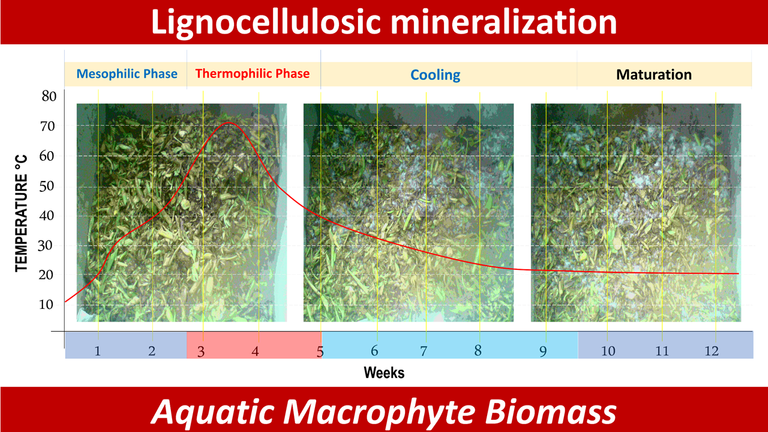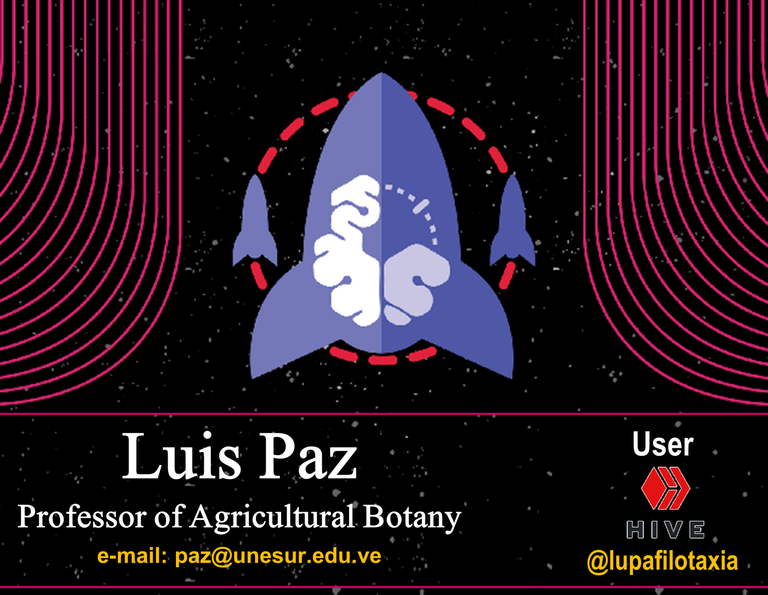Effect of thermophilic microorganisms in the composting process

Greetings dear friends and members of @ecoTrain, continuing with the theme of agro-ecological cut, in this opportunity, I will socialize with you, related to the process of mineralization of organic fertilizers based on aquatic plant biomass, through the incorporation of thermophilic microorganisms such as yeast Saccharomyces cerevisiae.
Introduction
The benefits of bioproducts based on aquatic plant biomass are unquestionable, in fact, in multiple investigations, it has been demonstrated the effect of compost obtained through the incorporation of aquatic plants, improve soil characteristics, such as fertility, water storage capacity, mineralization of nitrogen, phosphorus and potassium, which translates into favorable elements for the growth of cultivable plant species.
Hence, the importance of controlling each phase of the process of biodegradation of organic materials used for the production of compost, in order to obtain a stable bioproduct rich in soluble chemicals.
In any composting process, one of the most critical phases of biodegradation is the lignocellulosic mineralization, because the physical and chemical quality of the bioproducts depends on this action. For this reason, the objective of this article is to present everything related to the conceptualization of lignocellulosic mineralization, through the incorporation of thermophilic microorganisms, such as the yeast Saccharomyces cerevisiae.

Fig. 2 Phases of the lignocellulosic mineralization process Design and drawing: @lupafilotaxia.
Generalities of the process
Mineralization
From a theoretical-biological construct, mineralization implies, the alteration of a chemical element that is in an organic phase to its inorganic conversion, through the metabolic action of microorganisms.
Therefore, we can understand from an agricultural approach, that mineralization is about the process of transformation of the organic fraction of the soil or other organic materials, to biomolecules assimilable by plant species.
An example; of organic mineralization, is the process of conversion of organic nitrogen, to mineral nitrogen (ammonium NH4+), a compound that can be absorbed by the root hairs of the plants.
Lignocellulosic substances
Lignocellulosic substances represent the main structural components that give hardness to the cell wall of plant organisms, such as lignin, cellulose and hemicellulose.

Fig. 3 The photograph of the vegetative cross section of Eichhornia Crassipes, By Jacopo Prisco [CC BY-SA 4.0], En Wikimedia Commons. Design and drawing: @lupafilotaxia.
Lignin, appears as a biopolymer constituent of the colenquimatic and sclerimatic tissues, which provide support to the plant organs.
With respect to cellulose and hemicellulose, the former is characterized by being a high molecular weight carbohydrate, which confers physical and mechanical properties to the secondary walls of the vegetable fibers, while hemicellulose represents a cementitious structure based on hexose or pentoses, between lignin and cellulose.
Thermophilic microorganisms
The decomposition of lignocellulosic biomass is carried out by microorganisms, generally thermophiles, whose metabolic activity develops at temperatures between 40 and 70°C, due to the chemical and recalcitrant nature of lignin, cellulose and hemicellulose, which reflects the inability of non-thermal tolerant microorganisms to make these cellular substances biodegradable.
In the elaboration, of agricultural bioproducts, it has been determined the metabolic action in the thermophilic phase, of Gram-positive bacteria of the genus Bacillus sp., Actinomycetes and strains of yeasts Saccharomyces, which are technologically inoculated, in order to accelerate the mineralization of the process.
SCIENTIFIC CONTRIBUTIONS OF THIS PUBLICATION:
- The physical and chemical quality of the bioproducts (composts) based on aquatic plant biomass, is related to the inoculation with thermophilic microorganisms of metabolic action as the Saccharomyces cerevisiae, because it allows the solubilization of lignocellulosic elements contained in the biomass, favoring its subsequent assimilation into the crops of agricultural interest.
BIBLIOGRAPHIC REFERENCES CONSULTED:
[1] Azcón BT. Fundamentos de Fisiología Vegetal, 2da Edición. Publicaciones McGraw-Hill-Interamericana. Madrid, España. 2008.
[2] Biddlestone AJ., Gray KR., and Day CA. Composting and straw decomposition. In: Environmental Biotechnology (Eds Forster, C.F., and Wase AJ. Ellis Horwood Limited Publishers, Chichester, Engalnd, 1987; pp. 135–175.
[3] Fergus CL. Thermophilic and thermotolerant molds and actinomycetes of mushroom compost during peak heating. Mycologia, 1964; 56, 267–284.
OBSERVATION


0
0
0.000
#Posh Twitter:
https://twitter.com/lupafilotaxia/status/1340022306790395907
Great post, concise and well written. Thank you!
Hello @paradoxtma
Thank you for the positive feedback, best regards and read on.
Your post has been submitted to the OCD community curation initiative for some great upvotes! OCD are currently supporting posts in HIVE communities!
Congrats and keep posting great content!